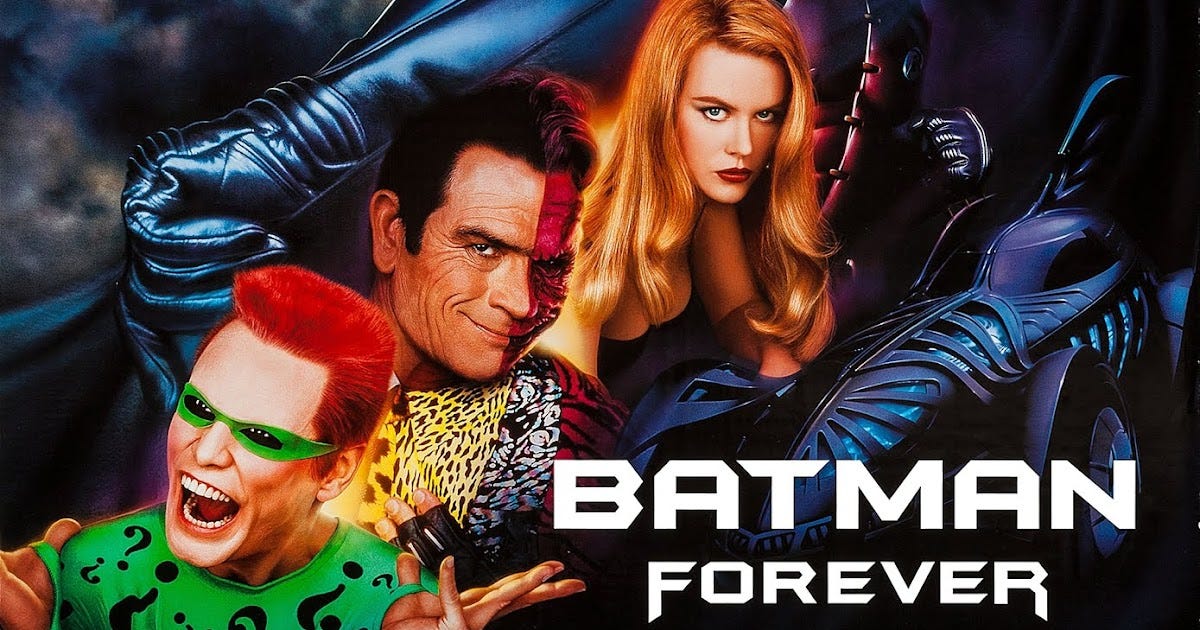AIR GUITAR is a 100% reader-supported publication. Each issue is researched, written, and edited by Art Tavana. If you want more AIR GUITAR, please support it as a paid subscriber.
AIR GUITAR #5 🤘🏻
OK, so I rewatched Batman Forever (1995) for the first time since its theatrical release THIRTY YEARS AGO. It’s been that long since this film — let’s call it a blockbuster — was dropped onto our laps like a rodent-shaped time bomb (the same year as Toy Story and Braveheart).
1995 was a cuckoo-for-cocoa-puffs year: Timothy McVeigh blew up the world, Coolio’s “Gangsta’s Paradise” was number-one, the final days of grunge-pop were upon us, ER was the highest-rated show on TV, Brad Pitt (who looked like a sexy burn victim) was People’s “Sexiest Man Alive,” and nobody cared about your mental health, except Hollywood.
IMHO, Batman Forever is era’s boldest and most bombastic blockbuster: a star-studded dark comedy with moments of juvenile exhilaration (e.g., Robin taking the Batmobile for a joyride like his big bro’s super-charged Mustang), Jim Carrey’s hammed-up homoerotic Riddler in lesbian drag (a bold swing for an actor at the height of his commercial powers), disabled Tommy Lee Jones with dissociative identity disorder, Val Kilmer’s trauma-ridden Batman with a nice ass, trauma porn, and BDSM jokes, in a movie for kids.
I giggled, screamed, cringed, struggled with my mental health, texted someone about the shitty puns and double-entendres, posted about Nicole Kidman’s Bond girl-meets-screwball Veronica Lake-coded performance as a highly unethical therapist (Chase Meridian) who’s constantly seeking romance in all the wrong places, including her patients, like some horny, campy, vulnerable, wacky (“wacko”), and trad ‘Sex in the City’ character who has a boxing bag in her office so she can glisten when her patients (usually men) show up for their sessions.
RIP, Joel Schumacher and peak male gaze filmmaking.
This is not a great film (is it even a film?), OK, but it is, without a question, a GREAT blockbuster — maybe the finest blockbuster-as-an-experience ever if you contextualize it with its supporting media: No Marvel, no Star Wars, a soundtrack with a Billboard number-one hit ballad by Seal (“Kiss From a Rose”), the George Lucasian desire to treat the fandom like a joke, the fantastic CD jewel case, the U2 video (the last time U2 felt “cool” or “punk”), the Happy Meal toys, the faux-crystal mugs, comic books, trading cards, the iconic John Alvin movie poster, glow-in-the-dark T-shirts, Herb Ritts’ sultry publicity photos, the exploitation of star power (and studio money), the homage to Fritz Lang (and Looney Tunes), Batman as Wile E. Coyote, cool costumes (Batman’s iconic Panther suit) Drew Barrymore’s cameo as a pre-code sex kitten (a tribute to John Barrymore-era starlets), and “cutie patootie” Chris O’Donnell, who was pitched to us as the new James Dean, who didn’t even turn out to be the new Luke Perry!
As a commercial enterprise, Batman Forever was a juggernaut, pulling in three-times its production budget (earning $330 million plus at the box office, second only to Toy Story), making Batman commercial again — giving us “Bat Summer” before “Brat Summer” — and fully establishing the fact that you did not need a logical script or any respect for the IP to produce a blockbuster; all you needed was star power, sex, lots of money, and toys (not sex toys), which is what this movie is: a visual feast that bombards you with capitalism and hormones.
‘Twas a different time with the same coordinates: SAME BAT TIME, SAME BAT CHANNEL (currently streaming on HBO Max or just MAX or HBO GO-MAX-GO-SPEED-RACER-GO, HBO).
I hate this film. I love this film. Is this even a film? My final takeaway is that Nicole Kidman’s face (her face as an idea — a confusing and wacky postmodern idea, like Garbo meets Animaniacs — is the film’s only unquestionable artistic achievement (NOT THAT IT MATTERS).
Note: Use of “wacky” and “wacko” in this review isn’t ableist as much as it is Batman Forever-ist.





